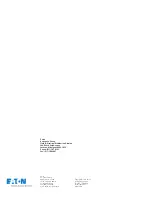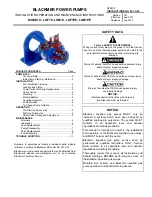
EATON
Aerospace Group
TF100-67A March 2013
3
Rynglok Fitting System Installation Guide
1.0
Initial Preparation
1.1
Cutting Tubes
Tubes may be cut using any appropriate cutting tool whether by
hand or by a production method. Tube ends should be reasonably
square, recognizing that any out-of-squareness condition will detract
from the amount of positioning tolerance allowed. (See paragraph
1.4)
1.2
Tube End Preparation
The tube ends should be deburred with appropriate deburring tools
on the O.D. and I.D. to prevent damage of the fitting I.D. during tube
insertion and to prevent FOD (Foreign Object Damage) from entering
and contaminating the fluid system.
1.2.1
Painted Tube End Preparation
Painted tube ends shall be deburred in accordance with paragraph
1.2. Painted tube ends do
not
require the paint to be removed when
the tubing O.D. is in accordance with Table 1. The max. tubing O.D.
(dim. A) must be held a min. distance (dim. B) per Table 1 for proper
fitting installation. If paint removal is necessary, the tube shall be
sanded in a radial direction using a mild grit paper. Care should be
taken to prevent longitudinal marks. It will be necessary to reclean
and remark tube ends. It is recommended to repaint the exposed
tubing after installation. Please contact Eaton’s Jackson, MI facility at
(517) 787-8121 if there are any questions regarding this procedure.
1.3
Pre-applied Tube End Marking
A pair or pairs of marks, (positioning marks and inspection marks) as
shown in Figure 1, should be pre-applied with the given dimensions
from Table 1 to each prepared tube end prior to fitting installation.
A suitable method such as ink stamp, electro-etch, laser, etc. may
be used. Should the tube ends be unmarked, the appropriate marks
should be applied using Eaton’s Aeroquip brand tube marking gauge
P/N RTSG0-01-SIZE as shown in Figure 2, and using a suitable per-
manent ink felt tipped pen.
Notice:
Due to the possibility of contaminating titanium tubing, inks
which contain lead or free halogens should not be used for marking.
1.4
Marking Gauge Positioning
The RTSG0-01-SIZE series of marking gauges is common for all
pressure classes of Rynglok fittings. The marking gauge should be
bottomed on the end of the cut tube. If an out-of-square condition
exists, the marking gauge should be positioned toward the end that
is most square. This is only for fittings which require shared inser-
tion, such as in the case of a union fitting. This allows minimum tube
insertion on the opposite end of a union configuration should the
skew end be inserted to the maximum tube insertion condition. (See
paragraph 4.1.1 and Figure 7).
(All tubes should be marked prior to assembly in insure proper tube
insertions.)
Figure 1
Tube marking using electro-etch, ink stamp, or laser marking.
Dash
Size
A
Max.
B
Min.
C
± .005
D
± .005
E
± .005
-03
.190
.453
.300
.453
.644
-04
.254
.525
.300
.525
.717
-05
.316
.588
.300
.588
.780
-06
.379
.656
.300
.656
.843
-07
.441
.730
.300
.730
.918
-08
.505
.773
.350
.773
.963
-09
.567
.836
.350
.836
1.026
-10
.630
.899
.350
.899
1.088
-11
.692
.983
.350
.983
1.175
-12
.755
1.042
.350
1.042
1.232
-13
.817
1.110
.350
1.110
1.303
-14
.880
1.178
.350
1.178
1.369
-15
.942
1.249
.400
1.249
1.448
-16
1.006
1.299
.400
1.299
1.498
-20
1.256
1.572
.400
1.572
1.781
-24
1.507
1.882
.400
1.862
2.086
Table 1
Dimensions for electro-etch, ink stamp, or laser marking.
Figure 2
Application of tube insertion marks using RSTG0-01-SIZE marking gauge and
pen.






























